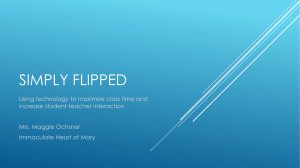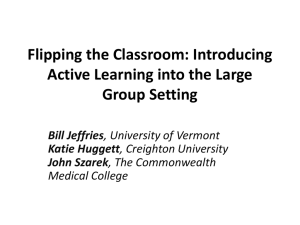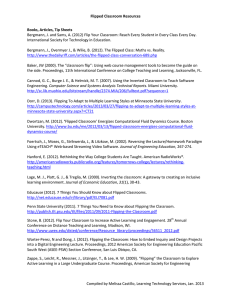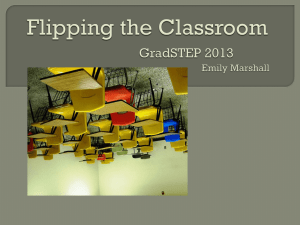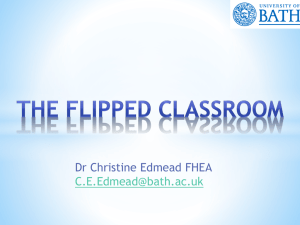1. What will you flip? Overview
advertisement
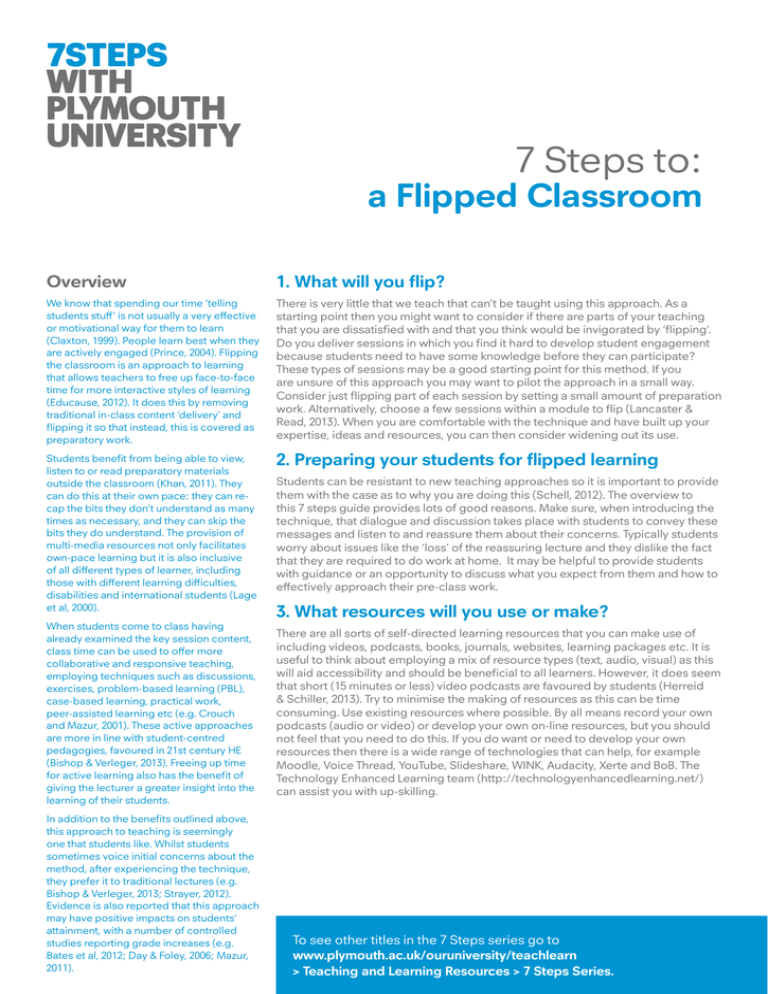
7STEPS WITH PLYMOUTH UNIVERSITY 7 Steps to: a Flipped Classroom Overview 1. What will you flip? We know that spending our time ‘telling students stuff’ is not usually a very effective or motivational way for them to learn (Claxton, 1999). People learn best when they are actively engaged (Prince, 2004). Flipping the classroom is an approach to learning that allows teachers to free up face-to-face time for more interactive styles of learning (Educause, 2012). It does this by removing traditional in-class content ‘delivery’ and flipping it so that instead, this is covered as preparatory work. There is very little that we teach that can’t be taught using this approach. As a starting point then you might want to consider if there are parts of your teaching that you are dissatisfied with and that you think would be invigorated by ‘flipping’. Do you deliver sessions in which you find it hard to develop student engagement because students need to have some knowledge before they can participate? These types of sessions may be a good starting point for this method. If you are unsure of this approach you may want to pilot the approach in a small way. Consider just flipping part of each session by setting a small amount of preparation work. Alternatively, choose a few sessions within a module to flip (Lancaster & Read, 2013). When you are comfortable with the technique and have built up your expertise, ideas and resources, you can then consider widening out its use. Students benefit from being able to view, listen to or read preparatory materials outside the classroom (Khan, 2011). They can do this at their own pace: they can recap the bits they don’t understand as many times as necessary, and they can skip the bits they do understand. The provision of multi-media resources not only facilitates own-pace learning but it is also inclusive of all different types of learner, including those with different learning difficulties, disabilities and international students (Lage et al, 2000). 2. Preparing your students for flipped learning When students come to class having already examined the key session content, class time can be used to offer more collaborative and responsive teaching, employing techniques such as discussions, exercises, problem-based learning (PBL), case-based learning, practical work, peer-assisted learning etc (e.g. Crouch and Mazur, 2001). These active approaches are more in line with student-centred pedagogies, favoured in 21st century HE (Bishop & Verleger, 2013). Freeing up time for active learning also has the benefit of giving the lecturer a greater insight into the learning of their students. In addition to the benefits outlined above, this approach to teaching is seemingly one that students like. Whilst students sometimes voice initial concerns about the method, after experiencing the technique, they prefer it to traditional lectures (e.g. Bishop & Verleger, 2013; Strayer, 2012). Evidence is also reported that this approach may have positive impacts on students’ attainment, with a number of controlled studies reporting grade increases (e.g. Bates et al, 2012; Day & Foley, 2006; Mazur, 2011). Students can be resistant to new teaching approaches so it is important to provide them with the case as to why you are doing this (Schell, 2012). The overview to this 7 steps guide provides lots of good reasons. Make sure, when introducing the technique, that dialogue and discussion takes place with students to convey these messages and listen to and reassure them about their concerns. Typically students worry about issues like the ‘loss’ of the reassuring lecture and they dislike the fact that they are required to do work at home. It may be helpful to provide students with guidance or an opportunity to discuss what you expect from them and how to effectively approach their pre-class work. 3. What resources will you use or make? There are all sorts of self-directed learning resources that you can make use of including videos, podcasts, books, journals, websites, learning packages etc. It is useful to think about employing a mix of resource types (text, audio, visual) as this will aid accessibility and should be beneficial to all learners. However, it does seem that short (15 minutes or less) video podcasts are favoured by students (Herreid & Schiller, 2013). Try to minimise the making of resources as this can be time consuming. Use existing resources where possible. By all means record your own podcasts (audio or video) or develop your own on-line resources, but you should not feel that you need to do this. If you do want or need to develop your own resources then there is a wide range of technologies that can help, for example Moodle, Voice Thread, YouTube, Slideshare, WINK, Audacity, Xerte and BoB. The Technology Enhanced Learning team (http://technologyenhancedlearning.net/) can assist you with up-skilling. To see other titles in the 7 Steps series go to www.plymouth.ac.uk/ouruniversity/teachlearn > Teaching and Learning Resources > 7 Steps Series. References Bates, S. & Galloway, R. (2012). The inverted classroom in a large enrolment introductory physics course: a case study. The Higher Education Academy. Bishop, J.L. and Verleger, M.A. (2013). The Flipped Classroom: A Survey of Research. American Society for Engineering Education (ASEE). 120th ASEE Annual Conference & Exposition, Atlanta June 23-26 2013. Claxton, G. ( 1999) Wise Up: The Challenge of Lifelong Learning. London Bloomsbury Crouch, C and Mazur, E. (2001). Peer Instruction: Ten years of experience and results. Am. J. Phys. 69 (9), pp970-977. Day, J.A. and Foley, J.D. (2006). Evaluating a web lecture intervention in a human-computer interaction course. IEEE Transactions on Education, 49(4), 420-431. Educause (2012). 7 Things you should know about … Flipped Classrooms. Educause. http://net. educause.edu/ir/library/pdf/eli7081.pdf Heron, J. ( 1989 ) The Facilitators Handbook. London. Kogan Page Herreid, C.F and Schiller, N.A. (2013) Case Studies and the Flipped Classroom. Journal of College and Science Teaching, 42(5), 62-66. Khan, S. (2011). Let’s use videos to reinvent education. TED Lectures http://www.ted.com/ talks/salman_khan_let_s_use_video_to_reinvent_ education.html Lage, M.J., Platt, G.J. & Tregalia, M. (2000). Inverting the classroom : A gateway to creating an inclusive learning environment. Journal of Economic Education, 31(1), 30-43. Lancaster, S and Read, D. (2013). Flipping lectures and inverting classrooms. Education in Chemistry, 15, September 2013. http://www.rsc.org/images/ EIC0513-flipped-classroom-inverting-lectures_ tcm18-234703.pdf Mazur, E. (2011). Memorization or understanding: are we teaching the right thing? http://www. youtube.com/watch?v=tn1DLFnbGOo Novak, G. (2011). Just-in-Time Teaching. New Directions for Teaching and Learning, No. 128, 63-73. Prince, M. (2004). Does Active Learning Work? A Review of the Research, Journal of Engineering Education, 93(3), 223-231. ProfHacker (2010). Getting Students to Do the Reading: Pre-Class Quizzes on Wordpress. The Chronicle of Higher Education. ProfHacker blog. March 25, 2010. http://chronicle.com/blogPost/ Getting-Students-to-Do-the-/23066/ Schell, J. (2012). Student Resistance to Flipped Classrooms.Turn to Your Neighbour: The Official Peer Instruction Blog. March 2, 2012. http://blog. peerinstruction.net/2012/03/02/peer-instructionand-student-resistance-to-interactive-pedagogy/ Spencer, D., Wolf, D. and Sams, A. (2011). Are You Ready to Flip? http://www.thedailyriff.com/articles/ are-you-ready-to-flip-691.php Strayer, J. (2012). How learning in an inverted classroom influences cooperation, innovation and task orientation. Learning Environments Research, 15, 171-193. 4. How will you structure and guide the pre-class work? It is not sufficient to just provide students with self-directed resources such as podcasts or readings before a session. Some form of structure and instructions should also be provided to guide their preparation. For example, you may provide a series of questions to help them focus on the key issues that you will be covering in the session (e.g. Crouch & Mazur, 2001); or you may set up an online quiz (e.g. ProfHacker, 2010) that gives students immediate feedback and allows them to gauge if they have missed any key points. Be reasonable in the amount of preparation work you set. The abundance of high quality electronic resources available means that it is easy to go over-board. Think carefully about the limits to what resources you expect students to look at. Perhaps ask yourself ‘what can they reasonably be expected to view/read in an hour’? 5. Consider including ‘Just-in-time teaching’ A number of teachers experienced in offering the flipped classroom model use what is known as ‘just-in-time teaching’ (e.g. Novak, 2011). This is where students complete their pre-class work and then provide some form of response, e.g. they may take an on-line quiz. For example, Crouch & Mazur (2001) request online responses to three open questions including ‘What did you find difficult or confusing about the reading? If nothing, tell us what you found most interesting’. The teacher views student responses before the session and gets an insight into their students’ learning – what do they understand?; what are they getting stuck on? The teacher can then tailor the session to their students’ needs. Information on learning can also be gathered by looking at students’ use of electronic resources in order to see what they are spending their time looking at. 6. How will you flip your class time? Central to the concept of flipping is the opportunity to free up class time for more interactive pedagogies. If you choose to flip you will need to make decisions as to what approach or approaches you take (Spencer et al, 2011). Common approaches include discussions, project work (such as facilitating student-created content), problem-based learning (PBL), case-study learning, peer learning (facilitated with the use of clickers) etc. If you are not used to teaching using techniques that involve high levels of interaction in the classroom you may find it beneficial to seek out further support into these techniques (e.g. Heron, 1989). Make sure that you create alignment between the preparation work that you set and what you do in class. Students will need to know that they will be required to draw on their preparation in the class. Students quickly wise-up to session design and the implicit verbal messages from the lecturer that they can ‘get through’ the session without preparing. 7. Closing the loop: what to consider post-session? Build into your ‘flipped’ design those elements that help you close the learning loop: reflection, extension activities and evaluation. Consider how you will prompt reflection so that students are encouraged to deepen their understanding of what they have learnt in the session, evaluate it, make connections to the learning outcomes, and think about how this fits with their wider learning. Such reflection can be assisted by technology such as the DLE or a reflective tool such as Pebblepad. Post session is also the time to widen out the resources that you point your students to. Encourage their further reading and possibly provide extension activities. As with any new teaching activity it is also really valuable for you to evaluate what worked and what didn’t so that you can adjust your approach for next time. Educational Development Teaching and Learning The university is committed to providing information in accessible formats. If you require this publication in an alternative format, please contact Teaching & Learning on: +44 (0)1752 587608 Published 2014


